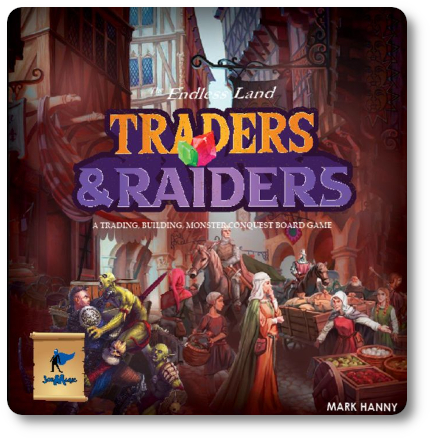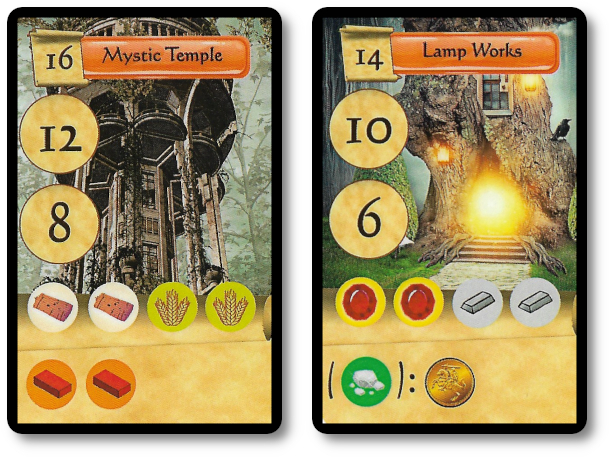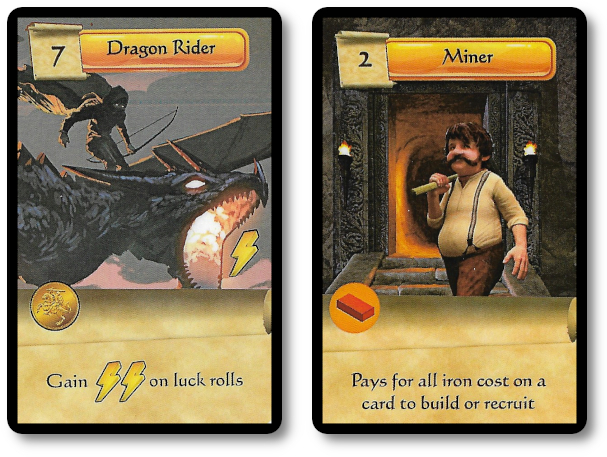 The Basics:
The Basics:
- For ages 12 and up
- For 1 to 5 players
- Approximately 90 minutes to complete
Geek Skills:
- Active Listening & Communication
- Counting & Math
- Logical & Critical Decision Making
- Reading
- Strategy & Tactics
- Hand/Resource Management
Learning Curve:
- Child – Moderate
- Adult – Easy
Theme & Narrative:
- Travel to a fantasy world to save villagers from monsters and establish trade routes
Endorsements:
- Child Geek rejected!
- Parent Geek mixed!
- Gamer Geek mixed!
Overview
In this game, players take on the persona of highly trained, adventurous entrepreneurs who seek to establish trade and make a good deal of gold by traveling different market routes under mountains, across the land, and over the sea. Along the way, players will encounter villages that need saving, monsters that need slaying, buildings that need building, and various other tasks, all focused on establishing a solid footprint in the local economy and gaining wealth. While this sounds somewhat daunting, the difficulty only increases when the player realizes they are not alone. Other players in this game have gladly taken up swords, shields, and accounting ledgers with the same goal. Time is short, and the markets are tight.
Traders and Raiders, designed by Mark Hanny and published by Joe Magic Games, is comprised of 30 Rare Resource tokens, 160 Uncommon Resource tokens, 90 Common Resource tokens, 40 Follower cards, eight Player cards, 40 Building cards, 16 Monster tokens, two game boards, eight Weappon tiles, 15 Map tiles, 16 Fortnight tiles, one Fortnight board, 40 Gold tokens, one standard six-sided die, a small collection of player components, and one cloth bag. The component quality is excellent, with thick cardstock and cardboard throughout. Also included are plastic organizers that come pre-packed with the components and ready to use at your gaming table.
Setting up the Game
To set up the game, complete the following steps.
First, place the two larger game boards together in the playing area. One board represents the areas the players will travel to and from, while the other tracks various cards and resources in play. The third and smaller Fortnight board should be set beside the two larger boards and will be used to keep track of how many Fortnight actions the players have taken during the game.
Second, shuffle the Follower and Building cards separately and in their own decks. Place each deck off to one side of the game board face-down. From these draw decks, draw the top-most card and place the numbered needed face-up on the game boards.
Third, add one of each Resource on the game board per their rarity.
Fourth, randomly place the Map tiles on the game board face-up and the Monster tokens face-down.
Fifth, mix all Fortnight tiles in the draw bag and draw one at random, placing it on the “Starting Goods” on the Fortnight board and one additional Resource of each kind displayed on the Fortnight tile.
Sixth, determine the player turn order and have each player select a Player card, matching tokens, and stand. All the Players are the same when it comes to starting bonuses. It’s just a matter of personal taste and color preference. Once collected and starting resources are provided to each player, have each player – in reverse turn order – place their Player standee in any Town space not already occupied by another Player standee.

This completes the game setup! Time to go on an adventure!
Fantasy Adventures in Sales and Marketing
Traders and Raiders is played in turns with no set number of turns per game. On the player’s turn, they take one action, which can be only for them to resolve (referred to as a “solo action”) or for all players to resolve (referred to as a “group action”). All actions are summarized here.
Solo Actions and Group Actions
A Group action allows all the players to take the same action in turn order sequence, while a Solo action only permits the active player to take the action. Solo actions can only be taken if another player has taken the same action as a Group action.
- Move: The player moves their Player standee using the roads to travel from their Town space to another. Players can acquire a Horse, Ship, and even a Dwarf Scout during the game to improve their movement and provide additional movement options. Unlike game setup, there is no limit to the number of Player standees in a Town or City space.
- Build: The player may pay the required resources to acquire a Building card, placing it in front of them or building a Building card already owned by another player by playing their Player token beside it. Buildings will provide players with resources during the game and points towards victory. Optionally, the player may buy a Market instead of a Building. Doing so will allow the player to trade in the Town they are located in.

- Trade: The player may trade for resources noted on the Town tile or any town with a Market tile. This action allows players to trade resources they might have in abundance for difficult ones to find.
- Recruit: The player may pay the cost to recruit a Follower, taking their matching card. Followers give players additional bonuses. Optionally, players can instead purchase a Weapon tile. Weapon tiles are used to give the player bonuses when attempting to rescue innocent victims from monsters.

- Collect: The player may take all the tokens of one type from the game board. The collected type must be available from the Town space the player is in.
- Rescue: If a monster is attached to the Town space where the player’s Player standee is currently located, they may attempt to rescue the village from the monster’s tyranny! A Fortnight tile is drawn and placed face-down to indicate the bonus the players will receive if the monster is defeated. To determine if the rescue is successful, the players compare numbers provided by the monster’s attack value with the player’s attack value. If the player is coming up short, they may spend their Weapon tile and luck with the die. Losing the battle means the player loses resources. Winning, however, means the player gains resources and keeps the Monster token, which will give them points towards victory at the end of the game.
Fortnight Action
Fortnight is a special Group action only available if three or more Group actions have already been selected. This action provides players a possible bonus and removes all Group actions from play, clearing it for players to use in the future. This action also updates the Follower and Building cards, removing the oldest and replenishing what is available to the players. Finally, taking the Fortnight action shifts the First Player to the left (following the turn order sequence).
Dominating the Marketfair
The game continues as noted above until the last space of the Fortnight track is taken due to a player taking the Fortnight Group Action. All players receive the bonus shown as usual. Each player gets one last Build, Recruit, or Trade action in turn order sequence. After which, the game ends.
Each player counts the points earned from Building cards, gold, monsters, and Follower cards. The player with the most points wins the game.
To learn more about Traders and Raiders, visit the game’s web page.
Final Word
 The Child Geeks were slow to pick up this game. It’s not because the game is overly difficult. I’ll classify this game as “medium weight” regarding difficulty. Instead, it’s the abundant number of actions the player can take and all the information you need to know when you glance at the board. As the comments reflect, It proved too overwhelming for our youngest players. According to one Child Geek, “I didn’t like the game. I found it confusing and never understood what I was doing or why.” Another Child Geek reported, “I like being a hero who is also a merchant and fights monsters and rescues people, but I didn’t understand the game well enough to have fun, and I found the game too confusing.” When the last monster was slain, and the villages freed, the Child Geeks took a vote and decided to move on.
The Child Geeks were slow to pick up this game. It’s not because the game is overly difficult. I’ll classify this game as “medium weight” regarding difficulty. Instead, it’s the abundant number of actions the player can take and all the information you need to know when you glance at the board. As the comments reflect, It proved too overwhelming for our youngest players. According to one Child Geek, “I didn’t like the game. I found it confusing and never understood what I was doing or why.” Another Child Geek reported, “I like being a hero who is also a merchant and fights monsters and rescues people, but I didn’t understand the game well enough to have fun, and I found the game too confusing.” When the last monster was slain, and the villages freed, the Child Geeks took a vote and decided to move on.
 The Parent Geeks found the different actions available to be a bonus and benefit to the game, unlike the Child Geeks, but that should not suggest that all Parent Geeks found the game to be close to their heart. The Parent Geeks were split regarding their thoughts on Traders and Raiders, with the deciding factor being the Parent Geek’s level of experience and preference for games. According to one Parent Geek who enjoyed the game, “This game has a lot to consider at any time, and everything you have available is empowering and meaningful. I enjoyed diving into the game, seeing my options, and was head over heels with the amount of strategy and tactical thinking I had to do without burning my brain.” According to a Parent Geek who was not in love with the game, “Oh, no. Not a game for me. There was too much going on and not enough feeling of getting anywhere to make it feel like I was making any progress. I understood perfectly how to make points and how to win the game, but every turn felt like I had to start from scratch. It’s just not a game for me. I need to see progress and momentum.” When the last market tent was open for business, the Parent Geeks took a vote with mixed results. Some wanted to stay and keep going, while others were pleased to walk away.
The Parent Geeks found the different actions available to be a bonus and benefit to the game, unlike the Child Geeks, but that should not suggest that all Parent Geeks found the game to be close to their heart. The Parent Geeks were split regarding their thoughts on Traders and Raiders, with the deciding factor being the Parent Geek’s level of experience and preference for games. According to one Parent Geek who enjoyed the game, “This game has a lot to consider at any time, and everything you have available is empowering and meaningful. I enjoyed diving into the game, seeing my options, and was head over heels with the amount of strategy and tactical thinking I had to do without burning my brain.” According to a Parent Geek who was not in love with the game, “Oh, no. Not a game for me. There was too much going on and not enough feeling of getting anywhere to make it feel like I was making any progress. I understood perfectly how to make points and how to win the game, but every turn felt like I had to start from scratch. It’s just not a game for me. I need to see progress and momentum.” When the last market tent was open for business, the Parent Geeks took a vote with mixed results. Some wanted to stay and keep going, while others were pleased to walk away.
 The Gamer Geeks were also mixed but for different reasons. For the Gamer Geeks, who had no issues quickly learning, understanding, and playing the game, their votes were split based on the game’s overall level of refinement. According to one Gamer Geek who enjoyed the game, “A game that feels old school meets new school. I like the many options available, which means I have many tactical approaches to obtaining the goals set by my strategy. I also enjoyed how the game constantly gave me information, which might feel a bit overwhelming and made the game difficult to grasp at first. Once I did, however, I loved it.” Another Gamer Geek not in the same camp said, “A game that felt like it had everything thrown at it, including the kitchen sink. The theme is lost, the game components are all over the place, and the actions feel like a list of all the other actions you could ever find in any other game that are thrown together here because why not? I played the game, won twice, lost once, and never felt like I did anything but work. Not a game for me.” When the last points were counted, Traders and Raiders found mixed victory with our elitist gamers.
The Gamer Geeks were also mixed but for different reasons. For the Gamer Geeks, who had no issues quickly learning, understanding, and playing the game, their votes were split based on the game’s overall level of refinement. According to one Gamer Geek who enjoyed the game, “A game that feels old school meets new school. I like the many options available, which means I have many tactical approaches to obtaining the goals set by my strategy. I also enjoyed how the game constantly gave me information, which might feel a bit overwhelming and made the game difficult to grasp at first. Once I did, however, I loved it.” Another Gamer Geek not in the same camp said, “A game that felt like it had everything thrown at it, including the kitchen sink. The theme is lost, the game components are all over the place, and the actions feel like a list of all the other actions you could ever find in any other game that are thrown together here because why not? I played the game, won twice, lost once, and never felt like I did anything but work. Not a game for me.” When the last points were counted, Traders and Raiders found mixed victory with our elitist gamers.
 Games like Traders and Raiders are why Father Geek exists. It’s a game designed for players, but who are those players? Casual gamers? Gaming elitists? New players to the hobby or veterans of the board and dice? Traders and Raiders, in my opinion, is designed for all and none of them precisely. It feels like a love letter and a passion project from the game designer rather than a game that was ever meant to be marketed explicitly to any one group. It’s a game, I believe, that exists because the game designer wanted it. It doesn’t fit any needs, doesn’t explore anything new, and certainly doesn’t attempt to bridge any gaps. It’s a game meant to be played, and that’s it. Like it? Great! Dislike it? Great!
Games like Traders and Raiders are why Father Geek exists. It’s a game designed for players, but who are those players? Casual gamers? Gaming elitists? New players to the hobby or veterans of the board and dice? Traders and Raiders, in my opinion, is designed for all and none of them precisely. It feels like a love letter and a passion project from the game designer rather than a game that was ever meant to be marketed explicitly to any one group. It’s a game, I believe, that exists because the game designer wanted it. It doesn’t fit any needs, doesn’t explore anything new, and certainly doesn’t attempt to bridge any gaps. It’s a game meant to be played, and that’s it. Like it? Great! Dislike it? Great!
Putting my theories aside, I was also on the fence regarding this game. It has many elements of gameplay that I have enjoyed from other games that require me to build, buy, store, gather, expand, and exploit. Indeed, I am drawn to these types of games, like a moth to a flame. Traders and Raiders had me smiling in glee and raising my eyebrows in puzzlement in equal measure. Did I enjoy the game? Yes. Did I love the game? No. Did I enjoy the challenge against my fellow players? Yes. Did I find the game to be a challenge in itself? No.
And around and around my mind goes.
I found Traders and Raiders to be very middle of the road, existing in an almost perpetual state of being deeply rooted in an uncanny “Goldilocks Zone.” When I walked away from the table, I neither felt satisfied nor dissatisfied. Not numb to the experience, mind you. Just – well – “spent.” I played, and I won, or I played, and I lost. Either way, I didn’t leave the table with any general feeling other than I played a game that was well thought out.
What I can say with absolute clarity is that this is not my favorite Joe Magic game, but nor is it a game I can say with certainty I wouldn’t play again. I will keep this game in my collection because it serves a gaming experience that is a buffet of individual gaming mechanisms set in a fantasy world full of monsters and economics. That’s a rarity.
This game was given to Father Geek as a review copy. Father Geek was not paid, bribed, wined, dined, or threatened in vain hopes of influencing this review. Such is the statuesque and legendary integrity of Father Geek.



